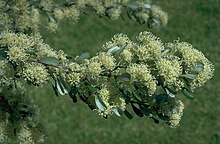| Grevillea argyrophylla | |
|---|---|

| |
| Grevillea argyrophylla in Kings Park | |
| Conservation status | |
 Least Concern (IUCN 3.1) | |
| Scientific classification | |
| Kingdom: | Plantae |
| Clade: | Tracheophytes |
| Clade: | Angiosperms |
| Clade: | Eudicots |
| Order: | Proteales |
| Family: | Proteaceae |
| Genus: | Grevillea |
| Species: | G. argyrophylla |
| Binomial name | |
| Grevillea argyrophylla Meisn. | |

Grevillea argyrophylla, the silvery-leaved grevillea, is a species of flowering plant in the family Proteaceae and is endemic to the south-west of Western Australia. It is an erect, sometimes low-lying shrub with egg-shaped leaves with the narrower end towards the base, and white flowers, sometimes tinged with pink.
Description
Grevillea argyrophylla is an erect, sometimes low-lying shrub that typically grows to a height of 0.6–2 m (2 ft 0 in – 6 ft 7 in) with softly-hairy branchlets. Its leaves are erect, egg-shaped with the narrower end towards the base, 15–60 mm (0.59–2.36 in) long and 2.5–8 mm (0.098–0.315 in) wide, often with a notch in the tip. The flowers are arranged in groups on a woolly-hairy rachis 1–4 mm (0.039–0.157 in) long, and are white, sometimes with a pink tinge. The pistil is 4–7 mm (0.16–0.28 in) long and glabrous. Flowering mainly occurs from July to October and the fruit is an oval follicle 6–10 mm (0.24–0.39 in) long.
Taxonomy
Grevillea argyrophylla was first formally described in 1855 by Carl Meissner in Hooker's Journal of Botany and Kew Garden Miscellany, from material collected by James Drummond. The specific epithet (argyrophylla) means "silvery-leaved".
Distribution and habitat
Silvery-leaved grevillea grows in heath and shrubland over limestone or sandstone in near-coastal areas from the Murchison River to Dandaragan and Jurien Bay in the Avon Wheatbelt, Geraldton Sandplains and Yalgoo biogeographic regions of south-western Western Australia.
Conservation status
This grevillea is listed as "not threatened" by the Government of Western Australia's Department of Biodiversity, Conservation and Attractions and as "Least Concern" on the IUCN Red List of Threatened Species. Despite its relatively small range, it is common and its population is stable. There are no known substantial threats to the species, either currently or in the immediate future.
References
- ^ Keighery, G.; Olde, P. (2020). "Grevillea argyrophylla". IUCN Red List of Threatened Species. 2020: e.T112646104A113307661. doi:10.2305/IUCN.UK.2020-2.RLTS.T112646104A113307661.en. Retrieved 20 December 2023.
- "Grevillea argyrophylla". Australian Plant Census. Retrieved 30 November 2021.
- ^ "Grevillea argyrophylla". FloraBase. Western Australian Government Department of Biodiversity, Conservation and Attractions.
- ^ "Grevillea argyrophylla". Australian Biological Resources Study, Department of Agriculture, Water and the Environment: Canberra. Retrieved 30 November 2021.
- "Grevillea argyrophylla". APNI. Retrieved 30 November 2020.
- Meissner, Carl (1855). "New Proteaceae of Australia". Hooker's Journal of Botany and Kew Garden Miscellany. 7: 75. Retrieved 30 November 2021.
- Sharr, Francis Aubi; George, Alex (2019). Western Australian Plant Names and Their Meanings (3rd ed.). Kardinya, WA: Four Gables Press. p. 137. ISBN 9780958034180.